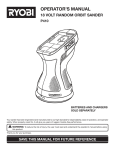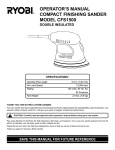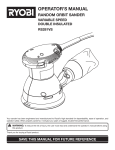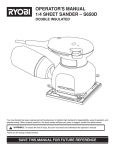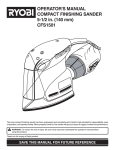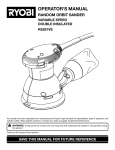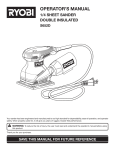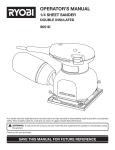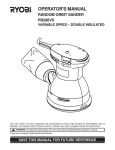Download Ryobi P400 Operator`s manual
Transcript
OPERATOR’S MANUAL 18 VOLT CORNER CAT™ FINISH SANDER P400 BATTERIES AND CHARGERS SOLD SEPARATELY Your Corner Cat™ Finish Sander has been engineered and manufactured to our high standard for dependability, ease of operation, and operator safety. When properly cared for, it will give you years of rugged, trouble-free performance. WARNING: To reduce the risk of injury, the user must read and understand the operator's manual before using this product. Thank you for your purchase. SAVE THIS MANUAL FOR FUTURE REFERENCE TABLE OF CONTENTS Introduction ..................................................................................................................................................................... 2 Warranty .......................................................................................................................................................................... 2 � General Safety Rules .................................................................................................................................................... 3-4 � Specific Safety Rules....................................................................................................................................................... 4 Safety Rules for Charger ................................................................................................................................................. 5 � Symbols ........................................................................................................................................................................ 6-7 � Features ........................................................................................................................................................................ 8-9 � Assembly ......................................................................................................................................................................... 9 � Operation .................................................................................................................................................................. 10-14 � Maintenance .................................................................................................................................................................. 15 � Parts Ordering / Service ................................................................................................................................................ 20 INTRODUCTION This tool has many features for making its use more pleasant and enjoyable. Safety, performance, and dependability have been given top priority in the design of this product making it easy to maintain and operate. WARRANTY RYOBI® POWER TOOL - LIMITED TWO YEAR WARRANTY AND 30 DAY EXCHANGE POLICY One World Technologies, Inc., warrants its RYOBI® power tools with the following conditions: 30-DAY EXCHANGE POLICY: During the first 30 days after date of purchase, you may either request service under this warranty or you may exchange any RYOBI® power tool which does not work properly due to defective workmanship or materials by returning the power tool to the dealer from which it was purchased. To receive a replacement power tool or requested warranty service, you must present proof of purchase and return all original equipment packaged with the original product. The replacement power tool will be covered by the limited warranty for the balance of the two year period from the date of the original purchase. WHAT THIS WARRANTY COVERS: This warranty covers all defects in workmanship or materials in your RYOBI® power tool for a period of two years from the date of purchase. With the exception of batteries, power tool accessories are warranted for ninety (90) days. Batteries are warranted for two years. HOW TO GET SERVICE: Just return the power tool, properly packaged and postage prepaid, to an Authorized Service Center. You can obtain the location of the Service Center nearest you by contacting a service representative at One World Technologies, Inc., P.O. Box 1207, Anderson, SC 29622-1207, by calling 1-800-525-2579 or by logging on to www.ryobitools.com. When you request warranty service, you must also present proof of purchase documentation, which includes the date of purchase (for example, a bill of sale). We will repair any faulty workmanship, and either repair or replace any defective part, at our option. We will do so without any charge to you. We will complete the work in a reasonable time, but, in any case, within ninety (90) days or less. WHAT’S NOT COVERED: This warranty applies only to the original purchaser at retail and may not be transferred. This warranty only covers defects arising under normal usage and does not cover any malfunction, failure or defects resulting from misuse, abuse, neglect, alteration, modification or repairs by other than Authorized Service Centers. One World Technologies, Inc. makes no warranties, representations or promises as to the quality or performance of its power tools other than those specifically stated in this warranty. ADDITIONAL LIMITATIONS: Any implied warranties granted under state law, including warranties of merchantability or fitness for a particular purpose, are limited to two years from the date of purchase. One World Technologies, Inc. is not responsible for direct, indirect, or incidental damages, so the above limitations and exclusions may not apply to you. This warranty gives you specific legal rights, and you may also have other rights which vary from state to state. 2 GENERAL SAFETY RULES Use safety equipment. Always wear eye protection. Dust mask, non-skid safety shoes, hard hat, or hearing protection must be used for appropriate conditions. Do not wear loose clothing or jewelry. Contain long hair. Loose clothes, jewelry, or long hair can be drawn into air vents. Do not use on a ladder or unstable support. Stable footing on a solid surface enables better control of the tool in unexpected situations. WARNING! READ AND UNDERSTAND ALL INSTRUCTIONS. Failure to follow all instructions listed below, may result in electric shock, fire and/or serious personal injury. SAVE THESE INSTRUCTIONS WORK AREA TOOL USE AND CARE Keep your work area clean and well lit. Cluttered benches and dark areas invite accidents. Do not operate power tools in explosive atmospheres, such as in the presence of flammable liquids, gases, or dust. Power tools create sparks which may ignite the dust or fumes. Keep bystanders, children, and visitors away while operating a power tool. Distractions can cause you to lose control. Use clamps or other practical way to secure and support the workpiece to a stable platform. Holding the work by hand or against your body is unstable and may lead to loss of control. Do not force tool. Use the correct tool for your application. The correct tool will do the job better and safer at the rate for which it is designed. Do not use tool if switch does not turn it on or off. A tool that cannot be controlled with the switch is dangerous and must be repaired. Disconnect battery pack from tool or place the switch in the locked or off position before making any adjustments, changing accessories, or storing the tool. Such preventive safety measures reduce the risk of starting the tool accidentally. Store idle tools out of reach of children and other untrained persons. Tools are dangerous in the hands of untrained users. When battery pack is not in use, keep it away from other metal objects like: paper clips, coins, keys, nails, screws, or other small metal objects that can make a connection from one terminal to another. Shorting the battery terminals together may cause sparks, burns, or a fire. Maintain tools with care. Keep cutting tools sharp and clean. Properly maintained tools with sharp cutting edges are less likely to bind and are easier to control. Check for misalignment or binding of moving parts, breakage of parts, and any other condition that may affect the tool’s operation. If damaged, have the tool serviced before using. Many accidents are caused by poorly maintained tools. Use only accessories that are recommended by the manufacturer for your model. Accessories that may be suitable for one tool may create a risk of injury when used on another tool. Keep the tool and its handle dry, clean and free from oil and grease. Always use a clean cloth when cleaning. Never use brake fluids, gasoline, petroleum-based products, or any strong solvents to clean your tool. Following this rule will reduce the risk of loss of control and deterioration of the enclosure plastic. ELECTRICAL SAFETY A battery operated tool with integral batteries or a separate battery pack must be recharged only with the specified charger for the battery. A charger that may be suitable for one type of battery may create a risk of fire when used with another battery. Use battery operated tool only with specifically designated battery pack. Use of any other batteries may create a risk of fire. Use battery only with charger listed. MODEL BATTERY PACK (P100) CHARGER (P110) P400 130255004 1423701, 140237023 or 130224028 or 140237021 PERSONAL SAFETY Stay alert, watch what you are doing and use common sense when operating a power tool. Do not use tool while tired or under the influence of drugs, alcohol, or medication. A moment of inattention while operating power tools may result in serious personal injury. Dress properly. Do not wear loose clothing or jewelry. Contain long hair. Keep your hair, clothing, and gloves away from moving parts. Loose clothes, jewelry, or long hair can be caught in moving parts. Avoid accidental starting. Be sure switch is in the locked or off position before inserting battery pack. Carrying tools with your finger on the switch or inserting the battery pack into a tool with the switch on invites accidents. Remove adjusting keys or wrenches before turning the tool on. A wrench or a key that is left attached to a rotating part of the tool may result in personal injury. Do not overreach. Keep proper footing and balance at all times. Proper footing and balance enable better control of the tool in unexpected situations. 3 GENERAL SAFETY RULES SERVICE When servicing a tool, use only identical replacement parts. Follow instructions in the Maintenance section of this manual. Use of unauthorized parts or failure to follow Maintenance Instructions may create a risk of shock or injury. Tool service must be performed only by qualified repair personnel. Service or maintenance performed by unqualified personnel may result in a risk of injury. SPECIFIC SAFETY RULES Do not place battery tools or their batteries near fire or heat. This will reduce the risk of explosion and possibly injury. Hold tool by insulated gripping surfaces when performing an operation where the cutting tool may contact hidden wiring. Contact with a “live” wire will also make exposed metal parts of the tool “live” and shock the operator. Never use a battery that has been dropped or received a sharp blow. A damaged battery is subject to explosion. Properly dispose of a dropped or damaged battery immediately. Know your power tool. Read operator’s manual carefully. Learn its applications and limitations, as well as the specific potential hazards related to this tool. Following this rule will reduce the risk of electric shock, fire, or serious injury. Batteries vent hydrogen gas and can explode in the presence of a source of ignition, such as a pilot light. To reduce the risk of serious personal injury, never use any cordless product in the presence of open flame. An exploded battery can propel debris and chemicals. If exposed, flush with water immediately. Always wear safety glasses with side shields. Everyday glasses have only impact resistant lenses. They are NOT safety glasses. Following this rule will reduce the risk of eye injury. Do not charge battery tool in a damp or wet location. Following this rule will reduce the risk of electric shock. Protect your lungs. Wear a face or dust mask if the operation is dusty. Following this rule will reduce the risk of serious personal injury. For best results, your battery tool should be charged in a location where the temperature is more than 50°F but less than 100°F. Do not store outside or in vehicles. Protect your hearing. Wear hearing protection during extended periods of operation. Following this rule will reduce the risk of serious personal injury. Under extreme usage or temperature conditions, battery leakage may occur. If liquid comes in contact with your skin, wash immediately with soap and water, then neutralize with lemon juice or vinegar. If liquid gets into your eyes, flush them with clean water for at least 10 minutes, then seek immediate medical attention. Following this rule will reduce the risk of serious personal injury. Battery tools do not have to be plugged into an electrical outlet; therefore, they are always in operating condition. Be aware of possible hazards when not using your battery tool or when changing accessories. Following this rule will reduce the risk of electric shock, fire, or serious personal injury. 4 SAFETY RULES FOR CHARGER WARNING! READ AND UNDERSTAND ALL INSTRUCTIONS. Failure to follow all instructions listed below, may result in electric shock, fire and/or serious personal injury. Before using battery charger, read all instructions and cautionary markings in this manual, on battery charger, battery, and product using battery to prevent misuse of the products and possible injury or damage. CAUTION: To reduce the risk of electric shock or damage to the charger and battery, charge only nickel-cadmium rechargeable batteries as specifically designated on your charger. Other types of batteries may burst, causing personal injury or damage. Do not use charger outdoors or expose to wet or damp conditions. Water entering charger will increase the risk of electric shock. Use of an attachment not recommended or sold by the battery charger manufacturer may result in a risk of fire, electric shock, or injury to persons. Following this rule will reduce the risk of electric shock, fire, or serious personal injury. Do not abuse cord or charger. Never use the cord to carry the charger. Do not pull the charger cord rather than the plug when disconnecting from receptacle. Damage to the cord or charger could occur and create an electric shock hazard. Replace damaged cords immediately. Make sure cord is located so that it will not be stepped on, tripped over, come in contact with sharp edges or moving parts or otherwise subjected to damage or stress. This will reduce the risk of accidental falls, which could cause injury, and damage to the cord, which could result in electric shock. Keep cord and charger from heat to prevent damage to housing or internal parts. Do not let gasoline, oils, petroleum-based products, etc. come in contact with plastic parts. They contain chemicals that can damage, weaken, or destroy plastic. An extension cord should not be used unless absolutely necessary. Use of improper extension cord could result in a risk of fire and electric shock. If extension cord must be used, make sure: a. That pins on plug of extension cord are the same number, size and shape as those of plug on charger. b. That extension cord is properly wired and in good electrical condition; and c. That wire size is large enough for AC ampere rating of charger as specified below: Cord Length (Feet) 25' 50' 100' Cord Size (AWG) 16 16 16 NOTE: AWG = American Wire Gauge Do not operate charger with a damaged cord or plug, which could cause shorting and electric shock. If damaged, have the charger replaced by an authorized serviceman. Do not operate charger if it has received a sharp blow, been dropped, or otherwise damaged in any way. Take it to an authorized serviceman for electrical check to determine if the charger is in good working order. Do not disassemble charger. Take it to an authorized serviceman when service or repair is required. Incorrect reassembly may result in a risk of electric shock or fire. Unplug charger from outlet before attempting any maintenance or cleaning to reduce the risk of electric shock. Disconnect charger from the power supply when not in use. This will reduce the risk of electric shock or damage to the charger if metal items should fall into the opening. It also will help prevent damage to the charger during a power surge. Risk of electric shock. Do not touch uninsulated portion of output connector or uninsulated battery terminal. Save these instructions. Refer to them frequently and use them to instruct others who may use this tool. If you loan someone this tool, loan them these instructions also to prevent misuse of the product and possible injury. IMPORTANT SAFETY INSTRUCTIONS 1. 2. 3. SAVE THESE INSTRUCTIONS This manual contains important safety and operating instructions for battery charger 1423701, 140237021 or 140237023. Before using battery charger, read all instructions and cautionary markings on battery charger, battery, and product using battery. CAUTION: To reduce the risk of injury, charge only nickel-cadmium rechargeable batteries. Other types of batteries may burst, causing personal injury or damage. 5 SYMBOLS Some of the following symbols may be used on this tool. Please study them and learn their meaning. Proper interpretation of these symbols will allow you to operate the tool better and safer. SYMBOL NAME DESIGNATION/EXPLANATION V Volts Voltage A Amperes Current Hz Hertz Frequency (cycles per second) W Watt Power Minutes Time Alternating Current Type of current Direct Current Type or a characteristic of current No Load Speed Rotational speed, at no load Class II Tool Double-insulated construction Per Minute Revolutions, strokes, surface speed, orbits etc., per minute Wet Conditions Alert Do not expose to rain or use in damp locations. Read The Operator’s Manual To reduce the risk of injury, user must read and understand operator’s manual before using this product. Eye Protection Always wear safety goggles or safety glasses with side shields and, as necessary, a full face shield when operating this product. Safety Alert Precautions that involve your safety. No Hands Symbol Failure to keep your hands away from the blade will result in serious personal injury. No Hands Symbol Failure to keep your hands away from the blade will result in serious personal injury. No Hands Symbol Failure to keep your hands away from the blade will result in serious personal injury. No Hands Symbol Failure to keep your hands away from the blade will result in serious personal injury. Hot Surface To reduce the risk of injury or damage, avoid contact with any hot surface. min no .../min 6 SYMBOLS The following signal words and meanings are intended to explain the levels of risk associated with this product. SYMBOL SIGNAL MEANING DANGER: Indicates an imminently hazardous situation, which, if not avoided, will result in death or serious injury. WARNING: Indicates a potentially hazardous situation, which, if not avoided, could result in death or serious injury. CAUTION: Indicates a potentially hazardous situation, which, if not avoided, may result in minor or moderate injury. CAUTION: (Without Safety Alert Symbol) Indicates a situation that may result in property damage. SERVICE WARNING: Servicing requires extreme care and knowledge and should be performed only by a qualified service technician. For service we suggest you return the product to your nearest AUTHORIZED SERVICE CENTER for repair. When servicing, use only identical replacement parts. To avoid serious personal injury, do not attempt to use this product until you read thoroughly and understand completely the operator’s manual. Save this operator’s manual and review frequently for continuing safe operation and instructing others who may use this product. WARNING: The operation of any power tool can result in foreign objects being thrown into your eyes, which can result in severe eye damage. Before beginning power tool operation, always wear safety goggles or safety glasses with side shields, or a full face shield when needed. We recommend Wide Vision Safety Mask for use over eyeglasses or standard safety glasses with side shields. Always use eye protection which is marked to comply with ANSI Z87.1. SAVE THESE INSTRUCTIONS 7 FEATURES PRODUCT SPECIFICATIONS Motor ......................................................................................................................................................................18 Volt DC Orbits Per Minute ................................................................................................................................................11,000 OPM Charger Input ....................................................................................................................................... 120 V, 60 Hz, AC only Charge Rate ..................................................................................................................................................................1 hour HEAVY-DUTY SCRUBBING PAD (RED) LIGHT SCRUBBING PAD (WHITE) POLISHING PAD (GRAY) ON/OFF SWITCH HOOK-AND-LOOP PAD SANDING SHEET Fig. 1 8 FEATURES KNOW YOUR CORNER CAT™ FINISH SANDER ORBITAL SANDING ACTION The oscillating action of your sander produces a very quick, small circular motion of the sanding pad. The motion is ideal for producing a fine finished grain or, when using the scrubbing pad, removing light rust, paint and other build up from the work surface. See Figure 1. The safe use of this product requires an understanding of the information on the tool and in this operator’s manual as well as a knowledge of the project you are attempting. Before use of this product, familiarize yourself with all operating features and safety rules. QUICK CHANGE HOOK-AND-LOOP PAD The hook-and-loop design allows for quick change of sanding sheets and scrubbing pads. It also enables you to easily clean and reuse them. ON / OFF SWITCH The ON (I) / OFF (O) slide switch is located on the front of the tool. TRI-FLEX PAD DESIGN The top two-thirds of each sanding pad is a detachable triangle that can be rotated to extend pad life and promote even wear. ASSEMBLY UNPACKING WARNING: This product has been shipped completely assembled. If any parts are missing do not operate this tool until the missing parts are replaced. Failure to do so could result in possible serious personal injury. Carefully remove the tool and any accessories from the box. Make sure that all items listed in the packing list are included. Inspect the tool carefully to make sure no breakage or damage occurred during shipping. Do not discard the packing material until you have carefully inspected and satisfactorily operated the tool. If any parts are damaged or missing, please call 1-800-525-2579 for assistance. WARNING: Do not attempt to modify this tool or create accessories not recommended for use with this tool. Any such alteration or modification is misuse and could result in a hazardous condition leading to possible serious personal injury. PACKING LIST Corner Cat™ Finish Sander 60-grit Sanding Sheet (1) 120-grit Sanding Sheet (1) 240-grit Sanding Sheet (1) Heavy-duty Scrubbing Pad (Red) (1) Light Scrubbing Pad (White) (1) Polishing Pad (Gray) (1) Lanyard (not included in combo) Operator’s Manual 9 OPERATION NOTE: Batteries will not reach full charge the first time they are charged. Allow several cycles (operation followed by recharging) for them to become fully charged. WARNING: Do not allow familiarity with tools to make you careless. Remember that a careless fraction of a second is sufficient to inflict serious injury. CHARGING A COOL BATTERY PACK If battery pack is within normal temperature range, the red LED on charger will come on. NOTE: If the charger does not charge the battery pack under normal circumstances, return both the battery pack and charger to your nearest Ryobi Authorized Service Center for electrical check. Charge the battery pack only with the charger provided. Make sure the power supply is normal household voltage, 120 volts, 60 Hz, AC only. Connect the charger to the power supply. Place the battery pack in the charger aligning raised rib on the battery pack with the groove in the charger. See Figure 2. Press down on the battery pack to be sure contacts on the battery pack engage properly with contacts in the charger. Normally the red LED on charger will come on. This indicates the charger is in fast charging mode. Red LED should remain on for approximately 1 hour then the green LED will come on. Green LED on indicates battery pack is fully charged and charger is in maintenance charge mode. NOTE: The green LED will remain on until the battery pack is removed from the charger or charger is disconnected from the power supply. If both yellow and green LEDs come on, this indicates a deeply discharged or defective battery pack. Allow the battery pack to remain in the charger for 15 to 30 minutes. When the battery pack reaches normal voltage range, the red LED should come on. If the red LED does not come on after 30 minutes, this may indicate a defective battery pack and should be replaced. After normal usage, a minimum of 1 hour of charging time is required to fully recharge battery pack. The battery pack will become slightly warm to the touch while charging. This is normal and does not indicate a problem. Do not place the charger and battery pack in an area of extreme heat or cold. They will work best at normal room temperature. NOTE: The charger and battery pack should be placed in a location where the temperature is more than 50°F but less than 100°F. When batteries become fully charged, unplug the charger from power supply and remove the battery pack. WARNING: Always wear safety goggles or safety glasses with side shields when operating tools. Failure to do so could result in objects being thrown into your eyes, resulting in possible serious injury. WARNING: Do not use any attachments or accessories not recommended by the manufacturer of this tool. The use of attachments or accessories not recommended can result in serious personal injury. APPLICATIONS You may use this tool for the following purposes: Sanding on wood surfaces Removing rust from and sanding steel surfaces Polishing and scrubbing porcelain and metal CAUTION: If at any point during the charging process none of the LEDs are lit, remove the battery pack from the charger to avoid damaging the product. DO NOT insert another battery. Return the charger and battery to your nearest service center for service or replacement. LED FUNCTIONS OF CHARGER LED WILL BE ON TO INDICATE STATUS OF CHARGER AND BATTERY PACK: Red LED on = Fast charging mode. Green LED on = Fully charged and in maintenance charge mode. Green LED on = When battery pack is inserted into charger, indicates hot battery pack or that battery pack is out of normal temperature range. Yellow and Green LEDs on = Deeply discharged or defective battery pack. No LED on = Defective charger or battery pack. CHARGING THE BATTERY PACK Battery packs for this tool are shipped in a low charge condition to prevent possible problems. Therefore, you should charge it until the green LED on the front of the charger comes on. 10 OPERATION CHARGING A HOT BATTERY PACK When using the tool continuously, the batteries in the battery pack will become hot. You should let a hot battery pack cool down for approximately 30 minutes before attempting to recharge. When the battery pack becomes discharged and is hot, this will cause the green LED to come on instead of the red LED. After 30 minutes, reinsert the battery pack in the charger. If the green LED continues to remain on, return battery pack to your nearest Ryobi Authorized Service Center for checking or replacing. NOTE: This situation only occurs when continuous use of the tool causes the batteries to become hot. It does not occur under normal circumstances. Refer to “CHARGING A COOL BATTERY PACK” for normal recharging of batteries. If the charger does not charge your battery pack under normal circumstances, return both the battery pack and charger to your nearest Ryobi Authorized Service Center for electrical check. YELLOW LED GREEN LED RED LED P110 CHARGER INSTALLING THE BATTERY PACK See Figure 2. WARNING: Always be sure the switch is in the OFF (O) position before installing the battery pack. Failure to do so could cause accidental starting, leading to serious personal injury. NOTE: The battery pack is shipped in a low charge condition. Therefore, it must be charged prior to use. Refer to page 10, “CHARGING THE BATTERY PACK” for charging instructions. Place the battery pack in the sander. Align the raised rib on the battery pack with the groove inside the sander, then slide the battery pack into the sander. BATTERY PACK SHOWN IN CHARGER Fig. 2 Make sure the latches on each side of your battery pack snap into place and the battery pack is secured in the sander before beginning operation. CAUTION: BATTERY PACK When placing battery pack in the tool, be sure raised rib on battery pack aligns with the bottom of the sander and latches into place properly. Improper installation of the battery pack can cause damage to internal components. LATCH REMOVING THE BATTERY PACK See Figure 3. Locate the latches on the side of the battery pack and depress them to release the battery pack from the sander. Remove battery pack from the sander. DEPRESS LATCHES TO REMOVE BATTERY PACK 11 Fig. 3 OPERATION WARNING: Battery tools are always in operating condition. Therefore, switch should always be locked when not in use or carrying at your side. SANDING SHEET AND PAD SELECTION Selecting the correct size grit and type sandpaper is an extremely important step in achieving a high quality sanded finish. Aluminum oxide, silicon carbide, and other synthetic abrasives are best for power sanding. Natural abrasives, such as flint and garnet, are too soft for economical use in power sanding. In general, coarse grit will remove the most material and finer grit will produce the best finish in all sanding operations. The condition of the surface to be sanded will determine which grit will do the job. If the surface is rough, start with a coarse grit and sand until the surface is uniform. Medium grit may then be used to remove scratches left by the coarser grit and finer grit used for finishing of the surface. Always continue sanding with each grit until surface is uniform. Sheet/Pad Recommended Use Heavy scrubbing pad Paint and rust removal (Part no. 019001001026) Light scrubbing pad Light scrubbing and cleaning (Part no. 019001001027) Polishing pad Polishing (Part no. 019001001028) 60-grit sanding sheet Coarse sanding (Part no. 019001001023) 120-grit sanding sheet Light sanding (Part no. 019001001024) 240-grit sanding sheet Finish sanding (Part no. 019001001025) HOOK-AND-LOOP PAD SANDING SHEET FUZZY SIDE Fig. 4 ON (I) OFF (O) WARNING: Always remove the battery pack when attaching, changing, or rotating sanding sheets. Failure to do so could cause accidental starting, leading to serious personal injury. ATTACHING SANDING SHEETS, SCRUBBING PADS AND POLISHING PADS ON (I) / OFF (O) SWITCH See Figure 4. Align the pointed tip and rounded edges of the sanding sheet or pad with the pointed tip and rounded edges of the hook-and-loop pad. Carefully press the fuzzy side of the sanding sheet against the pad as tightly as possible. Fig. 5 TURNING THE SANDER ON (I) / OFF (O) See Figure 5. Install the battery pack. To turn ON the sander: push the ON (I) / OFF (O) switch to the left. NOTE: Sanding sheets can be reused for the life of the sanding abrasive. It is recommended that you keep the sanding sheet backing pad clean to provide for best adhesion. Clean occasionally by brushing lightly with a small brush. To turn OFF the sander: push the ON (I) / OFF (O) switch to the right. 12 OPERATION OPERATING THE SANDER See Figure 6 - 7. Secure the workpiece to prevent it from moving under the sander. WARNING: Unsecured workpieces could be thrown towards the operator, causing injury. WARNING: Keep your head away from the sander and the sanding area. Your hair could be drawn into the sander causing serious injury. Place the sander on the workpiece so that all of the sanding sheet surface is in contact with the workpiece. CAUTION: WORKPIECE To avoid damaging the motor from overheating, be careful not to let your hand cover the air vents. SANDING IN CIRCULAR MOTIONS Fig. 6 SANDING IN CORNERS Fig. 7 Turn on the sander and move it slowly over the workpiece. Hold the sander in front and away from you, keeping it clear of the workpiece. Start sander and let the motor build to its maximum speed, then gradually lower the sander onto the workpiece. Move the sander slowly across the workpiece using small circular motions. Do not force. The weight of the unit supplies adequate pressure, so let the sanding sheet and sander do the work. Applying additional pressure only slows the motor, rapidly wears sanding sheet and greatly reduces sander speed. Excessive pressure will overload the motor causing possible damage from motor overheating and can result in inferior work. Any finish or resin on wood may soften from the frictional heat. Do not allow sanding on one spot too long, as the sander’s rapid action may remove too much material, making the surface uneven. Extended periods of sanding may tend to overheat the motor. If this occurs, turn sander off and wait until sanding sheet comes to a complete stop, then remove it from workpiece. Remove your hand from vent area, remove sanding sheet, then with your hand removed from vent area, turn sander on and run it free without a load to cool motor. For detail sanding such as corners and crevices, use the tip of the sanding pad with small back and forth motions. 13 OPERATION CHANGING SANDING SHEETS AND PADS HOOK-AND-LOOP PAD See Figure 8. The sander is packed with sanding sheets and scrubbing pads designed for a variety of uses. To change sheets and pads, simply pull the used sheet off the base and attach the desired sheet by pressing the sheet or pad onto the base of the sander. SANDING SHEET ROTATING THE SANDING SHEETS See Figure 9. The majority of wear in a precision sanding application occurs at the tip of the sanding sheet. The unique Tri-Flex design of the sanding sheets allows you to detach and rotate the top two thirds of each and extend the life of the sheet. To rotate the top of the sheet, simply remove the top two thirds along the perforation. Rotate the sheet so that a clean corner is located at the tip of the base. Press the sheet firmly onto the pad. NOTE: Scrubbing and polishing pads are not perforated and cannot be rotated. Fig. 8 ROTATING SANDING SHEET Fig. 9 14 MAINTENANCE Only the parts listed in this manual are intended to be repaired or replaced by the customer. All other parts should be replaced at a Ryobi Authorized Service Center. WARNING: When servicing, use only identical Ryobi replacement parts. Use of any other parts may create a hazard or cause product damage. CLEANING THE SCRUBBING PADS To ensure longer life and optimum performance, periodically clean all sanding residue and foreign materials from the scrubbing and polishing pads. This can be done simply by rinsing the pad with warm water until all foreign material has been washed away. After cleaning, gently squeeze the pad to remove excess water and allow pad to dry. Always store pads and sanding sheets flat in a cool dry location. WARNING: Always wear safety goggles or safety glasses with side shields during power tool operation or when blowing dust. If operation is dusty, also wear a dust mask. CLEANING THE SANDING SHEETS WARNING: The sanding sheets that came with the sander are made to be re-used. Therefore, it is important that they be cleaned periodically to remove sanding residue and foreign material that can accumulate over time. To clean sanding sheets, rub the sheets with a hard rubber block. You can also use the clean rubber sole of a shoe. To avoid serious personal injury, always remove the battery pack from the tool when cleaning or performing any maintenance. GENERAL MAINTENANCE Avoid using solvents when cleaning plastic parts. Most plastics are susceptible to damage from various types of commercial solvents and may be damaged by their use. Use clean cloths to remove dirt, dust, oil, grease, etc. WARNING: Always remove the scrubbing pad or sanding sheet from the sander before cleaning. Failure to do so could cause serious personal injury. WARNING: Do not at any time let brake fluids, gasoline, petroleumbased products, penetrating oils, etc., come in contact with plastic parts. Chemicals can damage, weaken or destroy plastic which may result in serious personal injury. BATTERIES BATTERY PACK REMOVAL AND PREPARATION FOR RECYCLING The battery pack for this tool is equipped with nickel-cadmium rechargeable batteries. Length of service from each charging will depend on the type of work you are doing. The batteries in this tool have been designed to provide maximum trouble-free life. However, like all batteries, they will eventually wear out. Do not disassemble battery pack and attempt to replace the batteries. Handling of these batteries, especially when wearing rings and jewelry, could result in a serious burn. To obtain the longest possible battery life, we suggest the following: To preserve natural resources, please recycle or dispose of batteries properly. This product contains nickel-cadmium batteries. Local, state or federal laws may prohibit disposal of nickel-cadmium batteries in ordinary trash. Consult your local waste authority for information regarding available recycling and/or disposal options. WARNING: Remove the battery pack from the charger once it is fully charged and ready for use. Upon removal, cover the battery pack’s terminals with heavy-duty adhesive tape. Do not attempt to destroy or disassemble battery pack or remove any of its components. Nickel-cadmium batteries must be recycled or disposed of properly. Also, never touch both terminals with metal objects and/or body parts as short circuit may result. Keep away from children. Failure to comply with these warnings could result in fire and/or serious injury. For battery storage longer than 30 days: Store the battery pack where the temperature is below 80°F. Store battery packs in a “discharged” condition. 15 OPERATOR’S MANUAL 18 VOLT CORNER CAT™ FINISH SANDER P400 WARNING: Some dust created by power sanding, sawing, grinding, drilling, and other construction activities contains chemicals known to cause cancer, birth defects or other reproductive harm. Some examples of these chemicals are: • lead from lead-based paints, • crystalline silica from bricks and cement and other masonry products, and • arsenic and chromium from chemically-treated lumber. Your risk from these exposures varies, depending on how often you do this type of work. To reduce your exposure to these chemicals: work in a well ventilated area, and work with approved safety equipment, such as those dust masks that are specially designed to filter out microscopic particles. • SERVICE Now that you have purchased your tool, should a need ever exist for repair parts or service, simply contact your nearest Authorized Service Center. Be sure to provide all pertinent facts when you call or visit. Please call 1-800-525-2579 for your nearest Authorized Service Center. You can also check our web site at www.ryobitools.com for a complete list of Authorized Service Centers. • MODEL NO. AND SERIAL NO. The model number of this tool will be found on a plate attached to the motor housing. Please record the model number and serial number in the space provided below. • HOW TO ORDER REPAIR PARTS When ordering repair parts, always give the following information: • MODEL NUMBER • SERIAL NUMBER P400 Ryobi® is a registered trademark of Ryobi Limited used under license. ONE WORLD TECHNOLOGIES, INC. 1428 Pearman Dairy Road, Anderson, SC 29625 Phone 1-800-525-2579 www.ryobitools.com 983000-622 10-25-06 (REV:02) 16

















